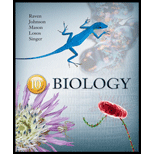
Concept explainers
Introduction:
Answer to Problem 1U
Correct answer:
Ability to conduct photosynthesis is not a characteristic of a fungus. Therefore, option c. is correct.
Explanation of Solution
Reason for the correct statement:
Fungi lack chloroplasts and hence they cannot conduct photosynthesis. They are heterotrophs that obtain food from their surroundings by secreting digestive enzymes and then absorbing the organic molecules produced as a result of external digestion.
Option c. is given as “ability to conduct photosynthesis”.
As, “Fungus cannot conduct photosynthesis”, is the right answer.
Hence, option c. is correct.
Reason for the incorrect statements:
Option a. is given as “Cell wall made of chitin”.
Fungus has cell wall made up of polysaccharide called chitin, so, it is a wrong answer.
Option b. is given as “A form of mitosis different from plants and animals”.
Fungus undergoes a different form of mitosis in which the nuclear envelope does not breakdown and reform, and the spindle apparatus is formed within the nucleus, so, it is a wrong answer.
Option d. is given as “Filamentous structure”.
Fungus may be either unicellular or filamentous structure, so, it is a wrong answer.
Hence, options a, b, and d are incorrect.
Fungus is heterotroph that obtains food from their surroundings by external digestion.
Want to see more full solutions like this?
- What term describes the close association of a fungus with the root of a tree? a. arhizoid b. a lichen c. a mycorrhiza d. anendophytearrow_forwardFungi would best be described as having which of the following life cycles? A. diploid-dominant B. alternation of generations C. gametophyte dominant D. haploid-dominantarrow_forwardFungi are all: a. multicellular b. eukaryotic c. decomposers d. single- celledarrow_forward
- The main growth form of fungi is made up of Select one: O a. hyphae O b. gametangia O c. fruiting bodies O d. sporangia O e. moldsarrow_forwardMycelium is a mass of conidia. A. True B. Falsearrow_forwardBasidiomycota is a division of the Kingdom Fungi. They include groups such as mushrooms, and reproduce sexually through the formation of cells called basidia. Which of the following rows identifies Process 1 and Process 3 in the life cycle shown in the diagram? Select one: a. Process 1 Process 3 Meiosis Mitosis b. Process 1 Process 3 Mitosis Mitosis c. Process 1 Process 3 Meiosis Meiosis d. Process 1 Process 3 Mitosis Meiosisarrow_forward
- The cell walls of fungi are strengthened by chitin, a strong but flexible polysaccharide. Which of these statements about the function of chitin in fungal cell wall is TRUE? a. Chitin-rich walls of fungi improves feeding by facilitated diffusion. b. The movement of water and nutrients into fungal cells creates pressure that could cause them to burst if they were not surrounded by a chitin-rich cell wall. c. The chitin present in fungal cell wall does not impart any advantage in terms of nutrient acquisition from the environment. d. Chitinous tubular cell walls confers motility to multicellular fungi.arrow_forwardWhich of the fungi species below has gametes that do NOT resemble animal sperm. A. cryptomycota B. chytrids C. ascomycotaarrow_forwardWhich of the following is a characteristic of fungi?a. autotrophicb. cellulose cell wallsc. external digestiond. sexual reproduction common in most speciesarrow_forward
- A scientist is interested in genetically engineering a fungus to hinder its reproductive process so that it does not spread fast. Which process should be disrupted to hinder fungal reproduction? A. Mycelium formation B. Nutrient absorption C. Septa formation D. Spore formation E. None of thesearrow_forwardWhich statement/s about fungi is/are true? * I. Fungi can live in marine environments. II. Saprophytic fungi are organisms that lives on dead or decaying organic matter. III. The active growth of fungi depends on a relatively high percentage of moisture in the environment. IV. Lichens are complex life form that is a symbiotic partnership of two separate organisms, a fungus and an alga.arrow_forward1)If we study septate and coenocytic hyphae of equal length from two fungi species, then the coenocytic hyphae is unique because A. It is haploid B. It has fewer pores in the wall C. It has more cytoplasm streaming d.Has cellulose in the cell wallsarrow_forward

 Concepts of BiologyBiologyISBN:9781938168116Author:Samantha Fowler, Rebecca Roush, James WisePublisher:OpenStax College
Concepts of BiologyBiologyISBN:9781938168116Author:Samantha Fowler, Rebecca Roush, James WisePublisher:OpenStax College

